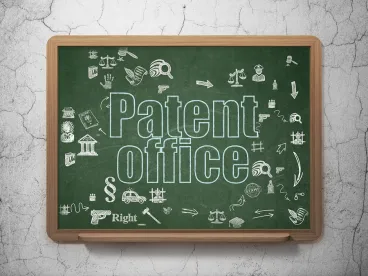On April 2, 2018, the U.S. Patent and Trademark Office released a memorandum to the Patent Examining Corps regarding recent subject matter eligibility decisions issued by the Federal Circuit. The memorandum discusses two recent decisions that found claims that improve computer technology are directed to patent-eligible subject matter rather than to an ineligible abstract idea. The memorandum and decisions are instructive for practitioners who draft patent applications, confront subject matter eligibility challenges or respond to USPTO rejections under 35 U.S.C. § 101.
In Finjan, Inc. v. Blue Coat Systems, Inc., 879 F.3d 1299 (Fed. Cir. 2018), the Court (Dyk, Linn, Hughes) found no error in the district court’s subject matter eligibility determination and unanimously held that the claims were patent-eligible under § 101 because they improved computer technology by protecting users against previously unknown viruses and enabled more flexible virus filtering. The invention recited specific steps to accomplish the desired result, and was a non-abstract improvement over traditional computer functionality and virus scanning techniques which only recognized the presence of previously-identified viruses.
Relying on recent Federal Circuit precedent, the Court stated that in cases involving software inventions, the inquiry into whether the claims are directed to an abstract idea often turns on whether the claims focus on a specific asserted improvement in computer capabilities. The claims at issue in Finjan are directed to a method of providing computer security by scanning a downloadable program for suspicious code such as viruses, and attaching the results of the scan to the downloadable program in the form of a security profile. The Court adopted a district court claim construction in finding that the behavior-based virus scan approach improved computer functionality because it determines whether the program performs hostile or potentially hostile operations.
In finding improved functionality, the Court refers to unclaimed features disclosed in the specification, such as the renaming or deleting files, as potentially dangerous or unwanted operations. In contrast to the improved behavior-based approach, conventional code-matching virus scans are limited to recognizing known viruses, typically by comparing the code in a downloadable file to a database of known suspicious code. The claimed security profile was found to improve computer functionality because it provides granular information about potentially suspicious code and can be used to protect against previously unknown viruses as well as known viruses that have been modified to avoid detection by conventional code-matching virus scans.
The Court again looked to the patent’s specification in determining that the security profile further improves computer functionality by allowing different security policies to be applied to different users or types of users and by enabling security policies to be modified in response to evolving threats. The security profile also allows a computer security system to perform functions it could not do before, such identifying threats before a program reaches a user’s computer and utilizing newly available, behavior-based information about potential threats.
Key practitioner tips that can be gleaned from Finjan include providing a robust specification disclosure and sufficiently detailed claimed features that indicate a particular improvement over conventional computer functionality. Finjan also indicates that it may be advantageous to include specification disclosure and particular language in the claims that describe how the improvement is implemented, rather than merely describing the desired end result or effect.
In Core Wireless Licensing S.A.R.L. v. LG Electronics, Inc., 880 F.3d 1356 (Fed. Cir. 2018), the panel (Moore, O’Malley, Wallach) unanimously affirmed the district court’s denial of summary judgment that the claims of two patents for an improved user interface for computing devices are directed to patent ineligible subject matter under § 101. The Court found the claims to be directed to a particular manner of summarizing and presenting information in electronic devices, and not abstract because they specify the type of data to be displayed and how to display it.
As in Finjan, the analysis begins by determining whether the claims are directed to a specific improvement in computer devices. The Court identified a multiplicity of claimed features in one of the independent claims, including an application summary that can be reached directly from a main menu that lists one or more applications and the ability to display the application summary while applications are in an un-launched state. The combination of these and other features provides a specific manner of summarizing and presenting information in electronic devices to an end-user. The claims provide a specific improvement over prior systems, like the improved systems claimed in Enfish, LLC v. Microsoft Corp., 822 F.3d 1327, 1338–39 (Fed. Cir. 2016), Thales Visionix Inc. v. United States, 850 F.3d 1343, 1348–49 (Fed. Cir. 2017), Visual Memory LLC v. NVIDIA Corp., 867 F.3d 1253, 1259 (Fed. Cir. 2017), and Finjan, 879 F.3d at 1303–05.
The Court relied on the patent specification in explaining that efficiency is improved by allowing “a limited list of common functions and commonly accessed stored data” to be accessed directly from the main menu, allowing a user to see the most relevant data or functions without opening the application, and needing only three steps “from start up to reach[] the required data/functionality.” The Court found that these features clearly indicate that the claims are directed to an improvement in the functioning of computers, particularly those with small screens.
The Court contrasted the improved functions with the functionality of prior art interfaces, which required users to scroll around and switch views many times to find the right data/functionality and drill down through many layers to access desired data or functionality. Known interfaces were deemed slow, complex and difficult to learn.
Core Wireless suggests that it may be beneficial to emphasize advantages of the invention in the specification that pertain to ease-of-use, operational and efficiency considerations with regard to a particular individual or entity, such as an end user, in conjunction with how such advantages are achieved. Enhancing or streamlining the experience of end-users of computer-related inventions in this manner can be considered an improvement in the functioning of computers that may qualify an invention as patent-eligible subject matter.
Finjan and Core Wireless stand in the wake a notable majority of Federal Circuit decisions[1]in recent years that have found claims of computer-related inventions to be directed to patent ineligible subject matter. These two decisions, the USPTO’s April 19, 2018 memorandum and April 20, 2018 request for comments pertaining to subject matter eligibility may spark discussion within the patent community that leads to additional guidance that clarifies whether computer-related patent claims are directed to patent-eligible subject matter.
[1] See https://www.uspto.gov/patent/laws-and-regulations/examination-policy/subject-matter-eligibility (then follow Chart of subject matter eligibility court decisions hyperlink (updated March 14, 2018)).




 />i
/>i

